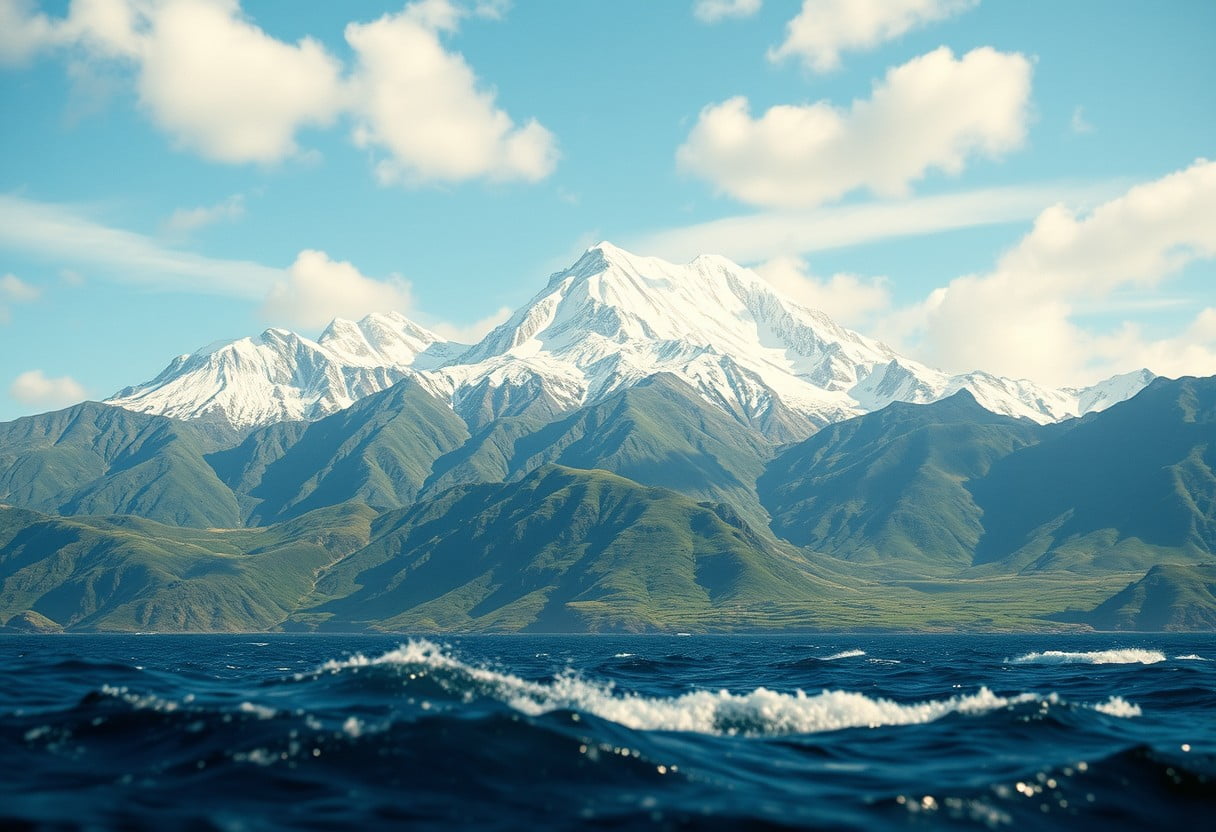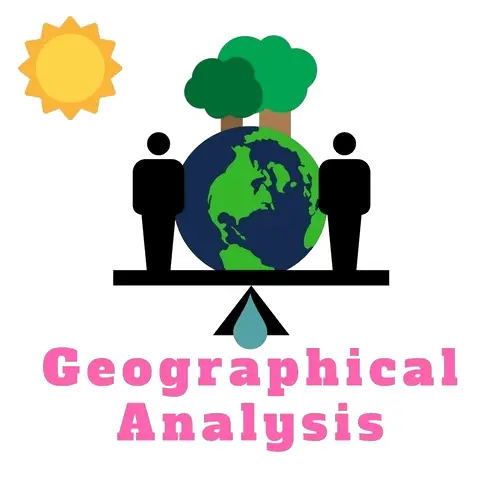There’s much more to the shape of our planet than meets the eye, as understanding the roles of oceans and mountains plays a pivotal part in geography. You may not realize how these natural features influence climate patterns, weather systems, and even the distribution of life on Earth. By delving into the intricate relationships between these geographical elements, you can gain a deeper appreciation for the dynamic forces that shape your environment. Join us as we explore how oceans and mountains define the contours of our world and impact your daily life.
Key Takeaways:
- Oceans play a crucial role in regulating the Earth’s climate and weather patterns, impacting biodiversity and human activities.
- Mountains serve as natural barriers that influence climate, ecosystems, and human settlements, often creating distinct habitats.
- Geographical formations such as oceans and mountains shape not only the physical landscape but also cultural and economic development in varying regions.
- Plate tectonics drive the formation of mountains and oceanic trenches, highlighting the dynamic nature of our planet’s surface.
- Research and understanding of oceanic and mountainous systems are imperative for effective environmental management and addressing global challenges such as climate change.
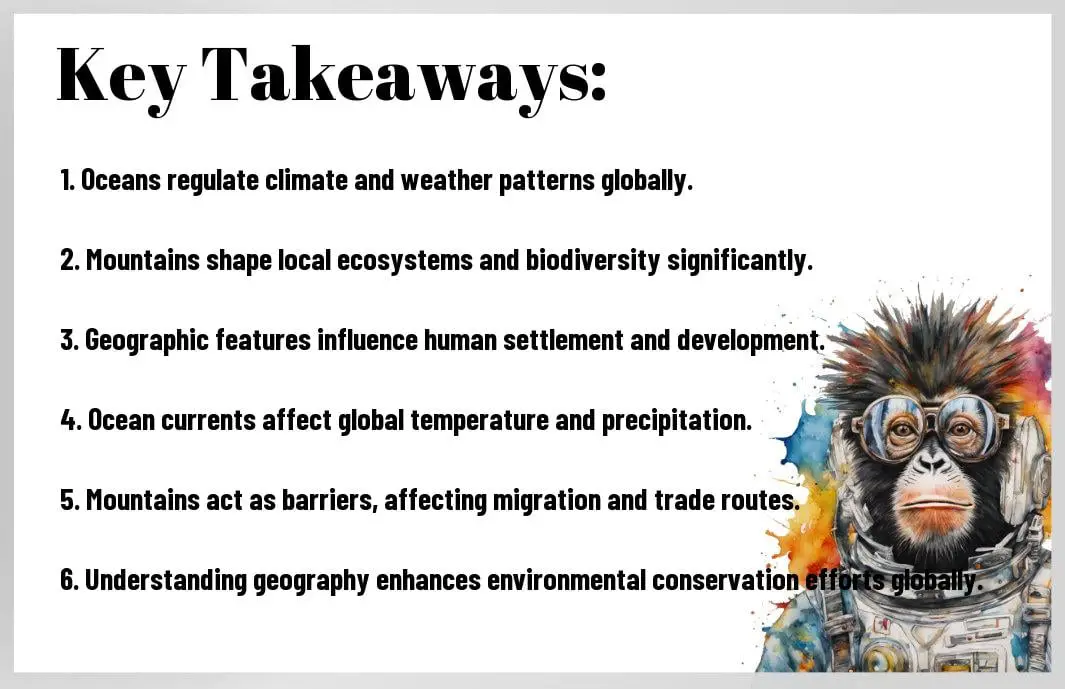
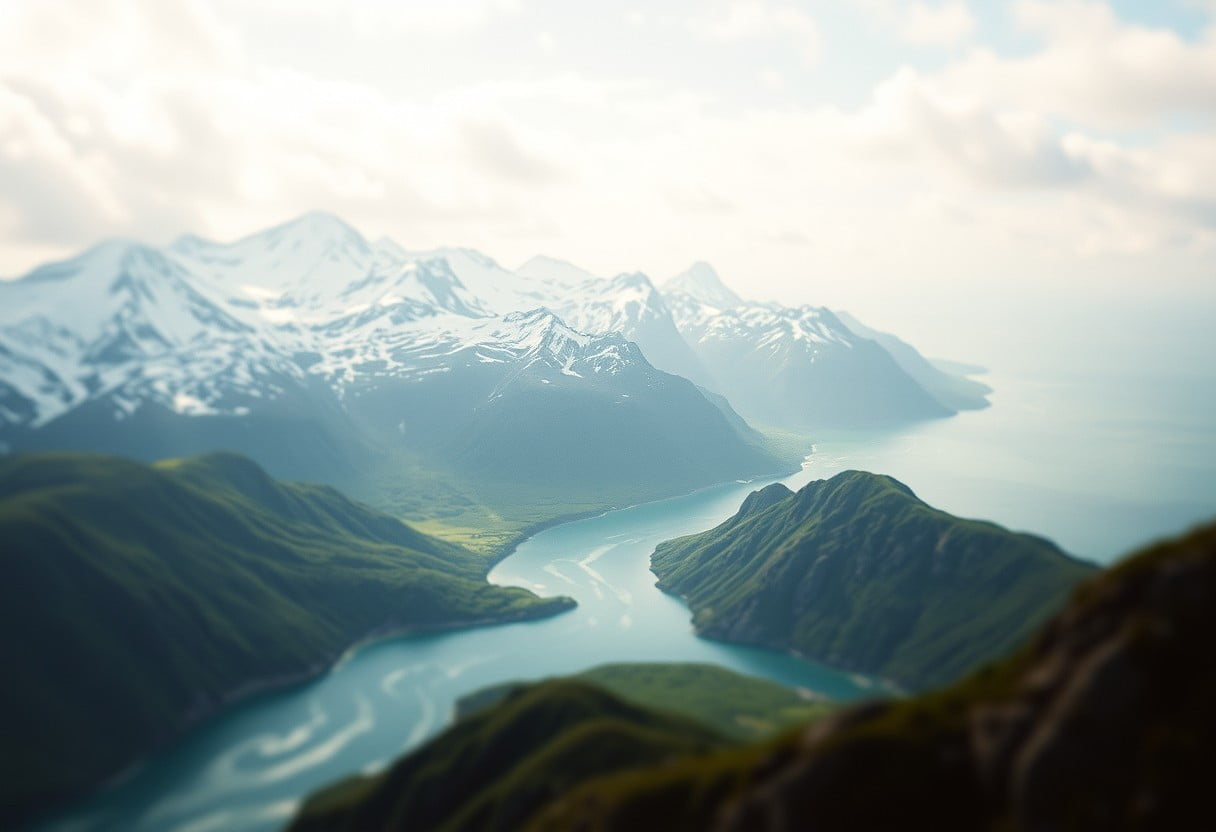
The Fundamental Structure of Earth
For those interested in the intricate workings of our planet, understanding the Earth’s fundamental structure is important. You will find that the Earth is composed of various layers, each with distinct characteristics and functions that contribute to the overall behavior of our planet. The layers work together to create the geological processes that shape your environment, from the mountains that rise majestically to the oceans that vast expanses cover. Recognizing these intricacies allows you to appreciate how different geological formations interact with one another and ultimately influence your daily life.
Layers of the Earth
Any discussion about the Earth’s structure begins with its layers. The Earth is generally divided into four main layers: the crust, mantle, outer core, and inner core. The crust is the outermost layer, which you interact with daily—consisting of solid rock and soil that forms the land and seabed. Beneath the crust lies the mantle, composed of semi-solid rock that flows slowly over geological timescales. Deeper still are the outer and inner cores, where molten metals and solid iron create an important component of Earth’s magnetic field. Understanding these distinctions helps you grasp how geological events, such as earthquakes or volcanic eruptions, occur and affect the surface of the planet.
The role of plate tectonics is another crucial aspect of understanding Earth’s structure. This theory explains how the Earth’s crust is divided into several large and small sections known as tectonic plates, which float on the semi-fluid mantle beneath. As these plates move, they create significant geological events, such as earthquakes and the formation of mountains, affecting landscapes and ecosystems worldwide. You may notice that the activity at the boundaries of these plates, including subduction and continental drift, leads not only to the creation of physical features but also shapes climatic conditions that impact your local environment.
The Role of Plate Tectonics
Structure and geological activity are deeply intertwined, and plate tectonics plays a crucial role in determining the characteristics of your landscape. As you learn more about this dynamic process, you’ll discover how the continuous movement of the Earth’s lithosphere reshapes the surface over time, leading to phenomena like the formation of mountain ranges and ocean basins. These tectonic movements can also result in natural disasters, reminding you of the planet’s ever-changing nature and the forces that drive geological transformation.
For instance, when two tectonic plates collide, one may be forced beneath the other in a process called subduction. This can lead to the formation of deep ocean trenches and volcanic arcs, profoundly influencing oceanic and atmospheric conditions. The interaction of plates not only creates stunning geological features but also contributes to the cyclical nature of Earth’s climate, as the arrangement and elevation of land masses affect atmospheric patterns, ocean currents, and consequently, the world in which you live. Understanding these complex interactions provides critical insight into the ongoing evolution of your planet.
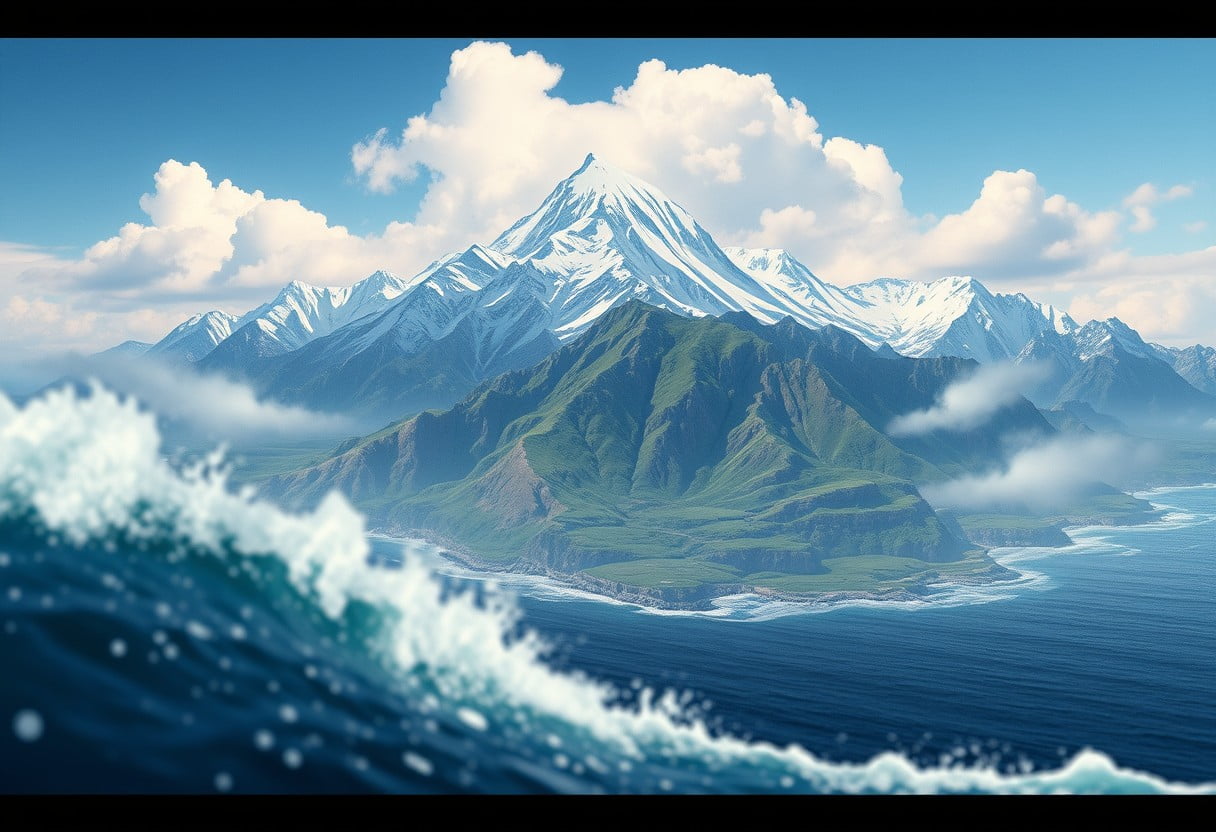
Oceans: The Lungs of Our Planet
Even in a world dominated by land, it is important to recognize that oceans play a crucial role in sustaining the very life we experience on Earth. These vast bodies of water are often referred to as the “lungs of our planet” because they generate more than half of the oxygen we breathe and are integral to our climate system. For a deeper understanding of the interactions that shape our home, you may find valuable insights in Planet Earth, explained. With their complex ecosystems and myriad functions, oceans are not only a source of beauty but are important to your survival.
The Importance of Ocean Currents
Lungs of the Earth also function through the currents that circulate within them. Ocean currents are pivotal in regulating global climate, influencing weather patterns, and facilitating the movement of nutrients across vast distances. These currents redistribute heat from the equator toward the poles, impacting both aquatic life and terrestrial weather systems. Understanding these currents helps you appreciate how interconnected the planet’s systems are and their direct influence on your daily life.
The movement of these currents can be viewed as the bloodstream of the ocean, ensuring that important nutrients reach marine ecosystems and supporting biodiversity. They play a role in transporting organisms, including fish and phytoplankton, thus sustaining the food web that nourishes countless species and, indirectly, humans as well.
Biodiversity in Oceanic Ecosystems
On the flip side, oceans boast an astounding level of biodiversity, hosting millions of marine species that thrive in diverse environments, from coral reefs to deep-sea trenches. This biodiversity is not only vital for the health of marine ecosystems but also provides resources and services that support human life. As you engage with the ocean, whether through recreation or dependence on its resources, understanding this diversity becomes crucial in fostering a sense of responsibility for marine conservation.
For instance, coral reefs, often called the “rainforests of the sea,” are teeming with life and provide shelter, food, and breeding grounds for over 25% of all marine species. They also protect coastlines from erosion and are a source of income through tourism and fishing. The loss of biodiversity in these ecosystems can lead to catastrophic consequences, highlighting the interdependence of your existence with the health of oceanic life.
The Impact of Oceans on Climate
With the oceans covering over 70% of the Earth’s surface, their influence on climate cannot be overstated. They act as significant carbon sinks, absorbing a considerable amount of carbon dioxide from the atmosphere and thereby moderating global temperatures. This natural process makes oceans critical players in the fight against climate change, offering you indirect benefits like stable weather patterns and a more hospitable environment for life.
As the climate shifts, oceans also contribute to phenomena such as sea-level rise and extreme weather events. Understanding how oceans are impacted by and contribute to climate change equips you to better comprehend global challenges and fosters a desire for sustainable practices to protect these vital ecosystems.
Ecosystems within the ocean are inherently intricate and delicate. You should be aware that human interactions, including pollution and overfishing, can disrupt these ecosystems and lead to dire consequences for climate stability. Preserving these systems is not just important for marine life but is also important for maintaining a balanced climate. By recognizing the role oceans play in these processes, you can participate in the collective effort to safeguard our planet’s future.
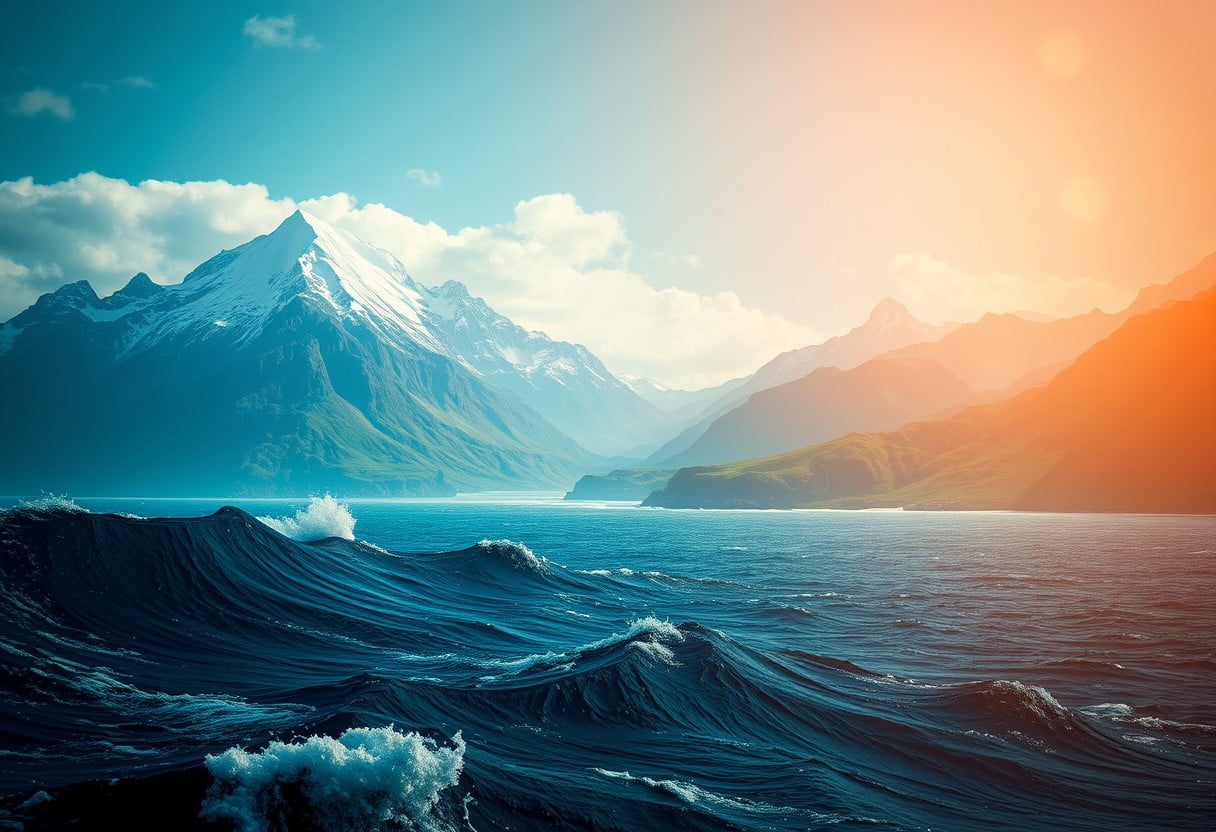
Mountains: Nature’s Barriers and Highways
Your understanding of mountains expands beyond their majestic peaks; they play a pivotal role in shaping our planet’s geography and ecology. These natural formations can be thought of as barriers and highways that dictate the movement of people, wildlife, and weather patterns. The incredible variety of mountains, such as volcanic, fold, and block mountains, stems from the processes that create them, which significantly influences both local and global environments.
Formation and Types of Mountains
For a clearer understanding, consider the processes of mountain formation which include tectonic activity, volcanic activity, and erosion. Below is a breakdown of the different types of mountains and how they are formed:
| Type of Mountain | Formation Process |
|---|---|
| Volcanic | Formed from volcanic eruptions |
| Fold | Created by the collision of tectonic plates |
| Block | Resulting from faulting and fracturing of the Earth’s crust |
| Plateau | Elevated flatlands caused by volcanic activity |
| Residual | Eroded remnants of once greater mountain ranges |
- Mountains can significantly change the terrain and ecosystems around them.
- They affect human settlement and accessibility.
- Different types of mountains create unique habitats.
- Majectic mountains often become focal points for tourism.
- Assume that mountains often dictate the region’s climate and weather patterns.
The Influence of Mountains on Weather Patterns
Influence of mountains on weather patterns cannot be overstated. They act as barriers that affect air currents and precipitation, leading to varied climates on either side of the same mountain range. As moist air rises over a mountain, it cools and condenses, resulting in precipitation. This phenomenon is known as orographic lift and is fundamental in controlling regional climates.
Highways through these mountainous terrains allow for human movement and interaction, impacting culture and economics significantly. A notable example is the Rocky Mountains in North America, where traversable paths have been necessary for trade and travel. As your understanding of these magnificent structures deepens, you’ll appreciate their dual role as barriers and connectors in geography.
Cultural and Economic Significance of Mountain Regions
Types of cultural and economic significance in mountain regions are abundant. Mountains not only shape local cultures with their scenic beauty and recreational opportunities, but they also provide necessary resources such as timber, minerals, and water. Many communities have developed unique cultures rooted in the mountains, celebrating traditions that are intertwined with their landscapes.
Mountain regions often foster tourism, which can be a vital part of a local economy. Visitors are drawn to activities such as skiing, hiking, and climbing, contributing significantly to the livelihoods of those living in these regions. Mountain ecosystems also provide necessary resources, underlining the need for thoughtful management to preserve their ecological integrity.
Mountain ranges function as more than just natural barriers; they are vital highways of commerce, culture, and biodiversity, connecting diverse ecosystems and societies across the globe.
Interactions Between Oceans and Mountains
To fully understand the intricate relationship between oceans and mountains, it’s important to observe how these two geographical features interact with one another. These interactions have profound implications for climate, biodiversity, and even human activities. Observing these relationships helps you appreciate the complexity of Earth’s systems and the role they play in shaping our environment.
The Influence of Coastal Mountains on Marine Life
With their mountainous terrain rising abruptly from the ocean, coastal mountains significantly influence marine ecosystems. The steep cliffs and rugged landscape can create unique habitats that support a diverse array of marine species. These habitats often lead to rich nutrient upwellings, which are important for the proliferation of phytoplankton, the foundation of the oceanic food web. As you explore coastlines around the world, you’ll find that areas with pronounced coastal mountains often boast an incredible variety of marine fauna, from vibrant coral reefs to thriving kelp forests.
Additionally, the presence of coastal mountains can alter local weather patterns, leading to increased precipitation in nearby ocean areas. This freshwater influx can profoundly impact salinity levels, influencing which species can thrive in those waters. Ultimately, understanding how coastal mountains shape marine life allows you to appreciate the delicate balance within ecosystems that depend on both land and sea.
How Mountains Affect Ocean Currents
Affecting ocean currents is one of the key roles mountains play in influencing the marine environment. Mountain ranges can disrupt the natural flow of ocean currents, creating pressure gradients that lead to the formation of eddies and gyres. When ocean currents encounter land, they are forced to redirect their paths, which can result in varying temperatures and salinity levels in the affected waters. By studying these interactions, you can better understand how marine climates differ and how they are vital for global weather patterns.
Mountains can also play a role in the formation of unique oceanographic features. For instance, steep coastal cliffs may channel wind, affecting surface currents, wind patterns, and local climatic conditions. This can create microclimates within the ocean, allowing for the establishment of diverse aquatic environments. By recognizing the effects of mountains on ocean currents, you’re gaining insight into how interconnected our planet really is.
The Role of Mountains in Sea-Level Changes
Sea level changes are intricately linked to the presence and activities of mountains. Sea levels are influenced not only by the melting of glaciers perched atop these towering geological formations but also by tectonic movements that can lift or sink coastal landscapes. As you follow the processes impacting sea levels, you’ll notice how mountain systems are often at the center of these changes, dictating the ebb and flow of maritime boundaries.
A comprehensive understanding of these dynamics is important for future climate predictions and coastal management. As mountains erode or build through geological processes, they can influence regional sea levels, impacting human settlements, ecosystems, and marine activities. Therefore, appreciating the role of mountains in sea-level changes will guide you in understanding how our continents and oceans interact with our planet’s ever-changing climate.
The Geographical Distribution of Oceans and Mountains
After examining the fundamental characteristics of our planet, it becomes clear that the geographical distribution of oceans and mountains significantly shapes the landscapes and climates experienced across various regions. These natural features influence not only the environment but also the biodiversity and human activities that take place on Earth. Understanding where oceans and mountains are situated can enhance your appreciation of how geography impacts weather patterns, natural resources, and even cultural practices.
Major Mountain Ranges Around the World
To truly comprehend the significance of mountain ranges, you must consider their vast influence on the surrounding areas. Major mountain ranges like the Himalayas, Andes, and Rockies act as formidable barriers that affect climate and weather patterns. These ranges can create rain shadows, leading to lush ecosystems on one side while producing arid landscapes on the other. For example, the Himalayas not only give rise to significant rivers such as the Ganges and Indus but also play a crucial role in shaping the climate of the Indian subcontinent.
To further illustrate their impact, mountain ranges are often rich in biodiversity, housing unique flora and fauna that may not exist elsewhere. Their varying altitudes and climates create microhabitats, providing a refuge for numerous species. By exploring these aspects, you gain a greater understanding of how mountains are not just barriers; they are lifelines for both ecology and human civilization.
Ocean Basins and Their Features
Any discussion of geographical distribution would be incomplete without acknowledging the vast ocean basins that cover approximately 71% of the Earth’s surface. These basins are home to a rich tapestry of features, including deep-sea trenches, mid-ocean ridges, and underwater volcanoes. The Pacific Ocean, being the largest and deepest, encompasses diverse environments, from coral reefs teeming with life to the enigmatic Mariana Trench, which plunges deeper than Mount Everest rises. Understanding these features is crucial for appreciating the vital role oceans play in regulating our planet’s climate and providing resources.
Any exploration of oceanic features also leads you to consider how currents circulate water, nutrients, and even heat around the globe. Ocean currents have a significant effect on climate by redistributing temperature disparities between the equator and the poles. They influence everything from yearly rainfall patterns to the migratory behavior of marine organisms. As you probe deeper into ocean basins, understanding these dynamics is vital for grasping their importance within our global ecosystem.
Mountain ranges and ocean basins are not merely scenic backdrops; they have profound implications for humanity. These regions often serve as natural borders for countries and can also impact socio-economic activities such as trade and resource distribution. Mountains may house valuable minerals, while oceans are gateways to trade routes and fishing grounds that sustains entire populations. Recognizing these relationships is key to understanding geopolitical dynamics in today’s world.
The Geopolitical Importance of Oceanic and Mountainous Regions
Oceans and mountains play a critical role not only in shaping the planet’s geography but also in influencing geopolitical strategies. Countries often vie for control over ocean territories rich in resources like oil and natural gas, as well as strategically important shipping lanes that facilitate trade. For example, the South China Sea is vital for international trade, making it a hotbed of territorial disputes among several nations. You must be aware of how geographical features can shape political affiliations, alliances, and conflicts.
This interplay between geography and politics extends to mountainous regions that can serve as natural barriers, influencing the security and defense strategies of nations. Due to their rugged terrain, mountains can be challenging to cross, providing strategic advantages or disadvantages during conflicts. They also act as natural buffers between nations, shaping how people interact across borders. Understanding these dynamics allows you to appreciate the complexities of international relations influenced by the geographical features of our planet.
Environmental Challenges Related to Oceans and Mountains
All around the world, oceans and mountains play a vital role in shaping our climate and ecosystems. However, they are facing numerous environmental challenges that threaten their stability and the biodiversity they support. As you explore these natural wonders, it’s important to understand the implications of climate change, erosion, and human activities on these vital systems.
Climate Change and Its Impact on Oceans
Oceans are often referred to as the Earth’s climate regulators, absorbing vast amounts of carbon dioxide and heat. However, the increasing levels of greenhouse gases have led to rising sea temperatures, causing coral bleaching and threatening marine life. You may be surprised to learn that as sea levels rise, coastal communities are at risk of flooding and loss of habitat, directly affecting millions of people who rely on these ecosystems for their livelihoods.
The acidification of oceans is another severe consequence of climate change, which occurs when the excess carbon dioxide is absorbed by seawater, altering its chemistry. This change can have devastating effects on shell-forming organisms such as mollusks and corals, which are vital components of marine food webs. It underscores the need for you to be aware of how climate change impacts these ecosystems and the broader implications for global biodiversity and food security.
Erosion and Degradation of Mountain Ecosystems
One of the pressing environmental challenges for mountain ecosystems is erosion, which can be accelerated by climate change and human activities. Factors such as deforestation, agriculture, and urban development disturb the soil and vegetation that help anchor the land, leading to increased erosion and degradation of these vital habitats. You should recognize that this not only affects the beautiful landscapes of mountains but also compromises the ecosystems and species that rely on them.
The impacts of erosion extend beyond the immediate area; sedimentation in rivers and streams can disrupt aquatic ecosystems, harming fish populations and other wildlife. As you engage with mountainous regions, keep in mind that your actions can either contribute to or mitigate these negative effects. Sustainable practices are vital in preserving these fragile environments for future generations.
Human Activities and Their Effects on Marine and Mountain Environments
To comprehend the extent of environmental challenges, you must consider the role of human activities. From overfishing to pollution, our actions have significant repercussions on both oceans and mountains. Unsustainable practices have led to declines in fish populations, loss of biodiversity, and degraded habitats, making it imperative for you to advocate for conservation and responsible usage of these precious resources.
With growing populations and expanding industries, the pressure on natural resources continues to mount. Your choices, from the seafood you consume to the products you buy, can directly impact the health of marine and mountain environments. Engaging in environmentally-friendly practices and supporting sustainable initiatives will help mitigate these challenges, ensuring these ecosystems can thrive for generations to come.
Conclusion
Drawing together the intricate threads that define our planet, it becomes evident that oceans and mountains play an indispensable role in shaping not only the physical landscape but also the broader geographical understanding of Earth. You should appreciate that oceans serve as vast reservoirs of biodiversity and climate regulators, influencing weather patterns and supporting life forms across multiple ecosystems. Meanwhile, mountains act as natural barriers and habitats, contributing to the distinct climates and cultures found in various regions. By recognizing how both these geological features interact, you can gain a deeper insight into the natural world and the forces that mold it.
Understanding the role of oceans and mountains in geography allows you to develop a more nuanced perspective on global issues, such as climate change, resource management, and urban development. As you explore the connections between these natural elements and human activity, you will be better equipped to engage with the pressing challenges of our times. Ultimately, fostering an appreciation for the shape of our planet enriches your knowledge base and encourages more sustainable practices in your own community, paving the way for a more cohesive coexistence with the Earth’s diverse landscapes.

